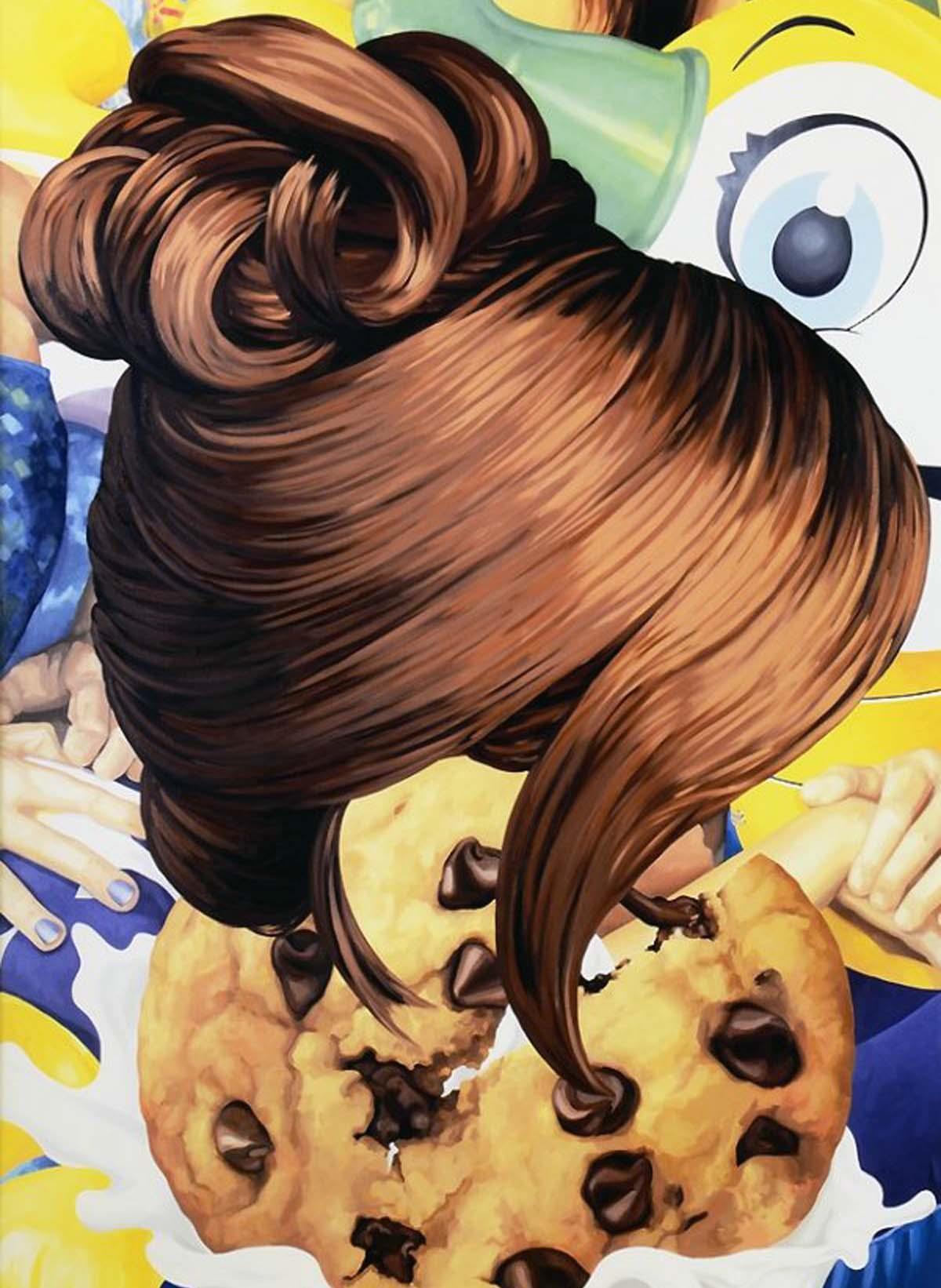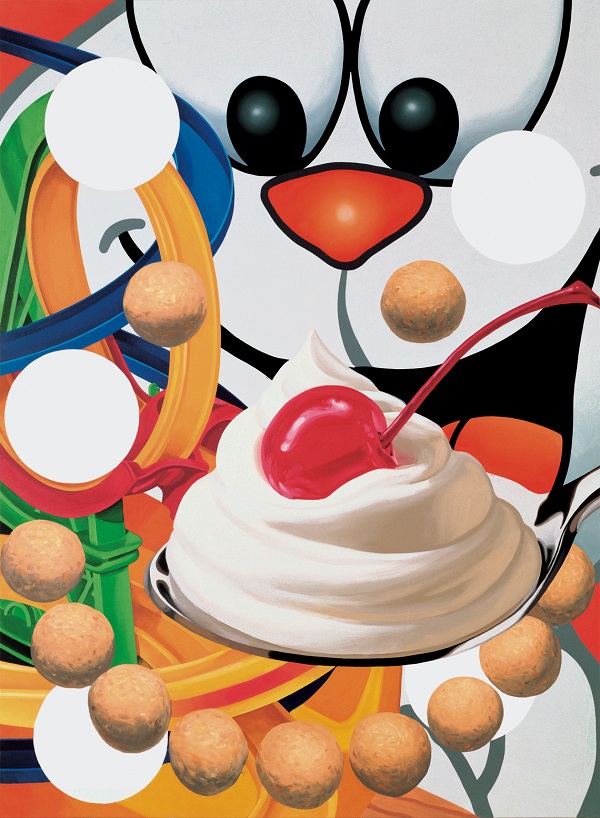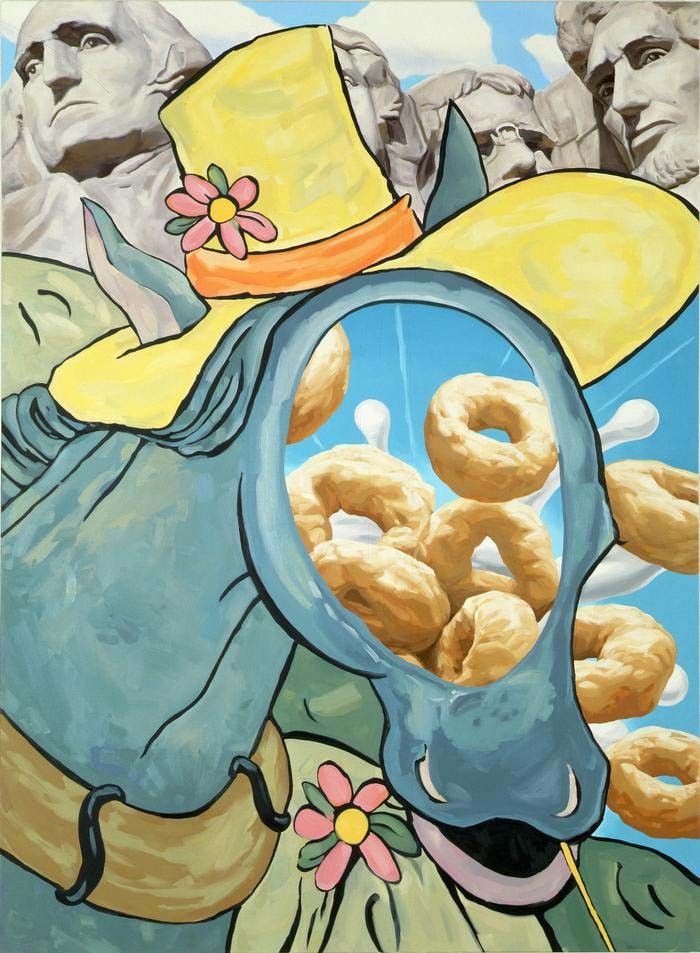After graduating with a degree in Fine Art from Maryland Institute College of Art, Koons moved to New York City in 1977 and found himself in a rocketing underground art scene of young artists; a new generation trying to break free from the prevalent minimalist art of simple aesthetic geometric shapes - and Conceptionalism, where the idea involved in the work was more influential than the visual appearance. Koons was no revolutionary comparable to the likes of
Robert Longo, Cindy Sherman or Richard Prince, a group of artists emerging in the mid-eighties and later coined as
‘The Pictures Generation’. His definition of revolt went as far as colouring his hair red and drawing a fake mustache on himself, in homage to his idol, the Spanish artist Salvador Dali.
As many rising artists in New York at the time, Koons was influenced by advertising, coupon-ads, newspapers and commercialism, but unlike his contemporaries, Koons work was not directly critical of the times. Instead, he found inspiration in and celebrated the banality of everyday objects - and created spotless sculptural work that was easily recognisable; acrylic-painted sponges placed in front of double-sided mirrors; a Hover vacuum cleaner installed in a perspex box; or a wall-hanging toaster in front of fluorescent lights. In the late seventies, he finished the series ‘Inflatables’; a series of colourful inflatable cartoon-like flowers made from plastic and vinyl, set against mirrors giving them an enhanced 3-dimensional sphere and making them “interact” with their surroundings through reflection. Appearing among the works of flowers was a 32” tall pink bunny with a carrot. “Inflatable” work would become a recurring theme embodying the artist’s practice - and among the most desirable artworks created by a living contemporary artist.

JEFF KOONS
Hair, 2000
Edition of 1000
61(w) x 86(h) cm
24.02(w) x 33.86(h) inches

JEFF KOONS
Hair, 2000
Edition of 1000
61(w) x 86(h) cm
24.02(w) x 33.86(h) inches
|
|
|
61(w) x 86(h) cm
24.02(w) x 33.86(h) inches
|
High Gloss Fujiflex print
Signed and numbered on verso.
This is a secondary market edition. Price is indicative and subject to the condition.
All image rights reserved by Jeff Koons
Edition of 1000
|
|
|
|
Available from a private collection
|
|
Koons faced a constant challenge financing the production of his unblemished sculptural work - and he knew he could not depend on grants of potential clients and galleries; people who were not overly eager to fund the dreams of another young and unknown artist. Still depending on a full-time job, Koons earned a license as a commodities broker in 1980, a profession he quickly found a natural flair. Koons was smooth, persuasive and with a soft and almost hypnological voice. His cold-calls to clients were instantly famed among his co-workers and would later be immortalised by actor Leonardo DiCaprio in the movie ‘The Wolf of Wall Street’. It was from his success as a broker, the artist was finally able to finance the art he really wanted to create.
The turning point in Koons’ career came in 1985 as part of a group show at International with Monument; a gallery in East Village on lower Manhattan. During the exhibition Koons’ works were noticed by the gallerist Ileana Sonnabend, who at the time was a dealer of many established Pop Art artists. In the autumn of the following year, the exhibition was moved to her gallery on West Broadway. Koons created ‘Statuary’, a series of works in stainless steel, for this show. Among the pieces was the ‘Rabbit’; highly inspired by the inflatable vinyl pink rabbit with a carrot from ’79 - and for this occasion, cast and produced in mirror-polished stainless steel. Three decades later one of the ‘Rabbit’, made as an edition of 3 plus an AP, was sold at Christies auction house in 2019 for $91m, premiums included.
From the mid-eighties Koons found a new freedom and endless source of productivity. ‘Banality’ (1988) was a series of sculptural pieces, best described as kitsch or questionable objects one might find at a yard sale; a white and gold painted porcelain figure of Michael Jackson with his monkey Bubbles - or a figure of Pink Panther hugging a blond mermaid. If the art world at this stage was puzzled, shortly hereafter he went full-blown controversial with the work “Made In Heaven”: sculptures in wood, marble and glass of Koons and his new wife, Illona Staller aka Cicciolina, the Hungarian-Italian port star, in pornographic poses - some of them in 1:1 size.

JEFF KOONS
Loopy, 2000
Edition of 1000
86(w) x 61(h) cm
33.86(w) x 24.02(h) inches

JEFF KOONS
Loopy, 2000
Edition of 1000
86(w) x 61(h) cm
33.86(w) x 24.02(h) inches
|
|
|
86(w) x 61(h) cm
33.86(w) x 24.02(h) inches
|
High Gloss Fujiflex print
Signed and numbered on verso.
This is a secondary market edition. Price is indicative and subject to the condition.
All image rights reserved by Jeff Koons
Edition of 1000
|
|
|
|
Available from a private collection
|
|
Koons’ next project would launch him into the art world stratosphere - and at the same time become a headache of epic proportions for the people financing him. Starting in 1992, the artist set out to create a body of work for an exhibition planned for Guggenheim Museum in New York. The title of the series was ‘Celebration’; a dedication to his son Ludwig. Thirty pieces were planned for the exhibition, including a 3-meter tall balloon dog, a 2-by-2-meter diamond ring and a similar sized hanging heart. In his signature mirror-polished stainless steel and colour coated in three to five different versions, the pieces were all to be completed to Koons’ scrutinising perfection. A perfection which has caused him to lose money on many of his pieces over the decades. Years into the project, and the exhibition at Guggenheim repeatedly postponed, the solo show was cancelled.
Exhausted by the complexity of ‘Celebration’, the constant ins-and-outs of financiers and the escalating cost to complete the seemingly never-perfect works, Koons started on a new body of work in the late nineties. Titled ‘Easyfun’, the artist went back to childish simplicity and it would mark his return to exhibiting after almost a decade in his studio. In 1999 the much-anticipated solo show opened. On show, a ‘Split Rocker’, a toddler rocker in hard-plastic made from two halves of a dinosaur’s and a horse’s head, five oil on canvas paintings - and thirteen cartoonish silhouettes of animals. The easily recognisable animal silhouettes, including a goat, a kangaroo, a hippo and a giraffe, were made from stainless steel, coloured crystal and mirrored glass, creating a reflective effect and bringing both the room and the viewer “into the artwork”. The use of mirrors and reflections is an effect Koons continuously explores in his practice in a desire to make his art interact with the surrounding world.
Koons saw ‘Cut Out’ as the American dream. You can become anything you want: a farm horse - or even president of the United States, as implied by Mount Rushmore in the background.
The oil on canvas works in ‘Easyfun’ were inspired by his fascination of cereal boxes and the imagery of consumer-culture America. From the age of four, Koons was enchanted by the cereal boxes in the morning, an experience the artist described as almost sexual at the age; the bright colours, the over-energetic cartoons - a cardboard box visually impossible to get tired of. The composition of
Loopy is the archetypical cereal box. A big cartoony character with a wide-open mouth, ready to eat the spoon of cream with a shiny-red cherry on top. On the left side is a loop for a race car track, referring to the toys once included in cereal boxes.
Similar imagery and collaged affects were explored in the other works on canvas. In
Hair, inspired by a coupon-ad, a faceless brunette beehive hairstyle takes centre stage, accompanied by a chocolate chip cookie, splashing into the flowing milk at the bottom. The all-American rural themes and aspiring values are also essential in
Cut Out. Here, the main figure is a farm horse, wearing a straw hat and chewing on a field flower. As suggested by the title,
Cut Out, the face of the horse is replaced with a cut-out hole, allowing the viewer hypothetically to step into the artwork and become a part of the scenery. Koons later commented that he saw
Cut Out as the American dream. You can become anything you want: a farm horse - or even president of the United States, as implied by Mount Rushmore in the background.

JEFF KOONS
Cut Out, 2000
Edition of 1000
61(w) x 86(h) cm
24.02(w) x 33.86(h) inches

JEFF KOONS
Cut Out, 2000
Edition of 1000
61(w) x 86(h) cm
24.02(w) x 33.86(h) inches
|
|
|
61(w) x 86(h) cm
24.02(w) x 33.86(h) inches
|
High Gloss Fujiflex print
Signed and numbered on verso.
This is a secondary market edition. Price is indicative and subject to the condition.
All image rights reserved by Jeff Koons
Edition of 1000
|
|
|
|
Available from a private collection
|
|
In the time passing after his break-through in 1985,
Jeff Koons has become one of the most influential contemporary artists. His work has been widely and globally exhibited, including museum exhibitions at the Guggenheim Museum in New York, Berlin and Bilbao - and ten retrospective solo shows around the world. In 2000 Koons received the ‘Chevalier of the Legion of Honor’ by the French president as a recognition of his unique reproduction of ’Split-Rocker’, made to celebrate Avignon’s status as European Capital of Culture. The 12-meter-tall steel sculpture was covered in a multitude of colourful flowers and, not surprisingly to the perfectionism of Koons, it had an internal irrigation system. Except for a series of new work titled ‘Gazing Ball’ (2013-15), the artist has since primarily focused on public installations and projects.
In the summer of 2000, three works from the series ‘Easyfun’ were released in an exclusive collaboration between
Jeff Koons, Sonnabend Gallery in New York and Eyestorm. The print editions,
Loopy,
Cut Out and
Hair, printed on high gloss Fujiflex, were each intended as an edition of 1,000, but less than 300 ended up being printed, numbered and initialised on verso. From the early 2000s, the print editions have only been available from private collectors and via auction houses.
You can find more information about the three print editions by
Jeff Koons on his artist page
here.
All image rights reserved by Jeff Koons.